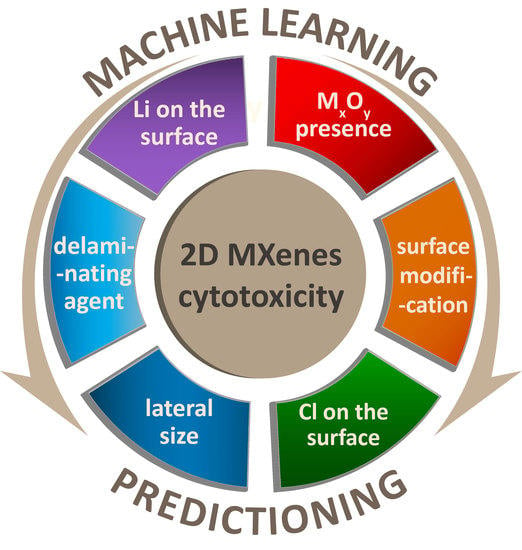Surface-Related Features Responsible for Cytotoxic Behavior of MXenes Layered Materials Predicted with Machine Learning Approach
Abstract
1. Introduction
2. Materials and Methods
2.1. The Choice of Descriptors
2.2. Datasets
- What kind of datasets and descriptors: theoretical, experimental or combined ones are sufficient to build a good quality ML model?
- Could the cytotoxic behavior be predicted based on purely theoretical descriptors (type of atoms, stoichiometry, etc.), and hence, does it mean that no experimental data need to be provided to predict the cytotoxic behavior?
- Does inclusion of the geometrical descriptors in the ML model improve qualitatively predictions of the cytotoxicity?
- Dataset I (experimental set)—the experimental data have been selected based on detailed description of the experiment, as well as detailed information about the structure, surface modification, in-depth characterization of morphology, and the cytotoxic effect of the MXenes compound on the cells tested in vitro. Those information have been collected from the literature listed in Table A1 and presented in Appendix A. It consists of 71 records and elemental features (descriptors) listed in Table A2.
- Dataset III (combined set)—dataset consists of both Dataset I and Dataset II. The number of the records and elemental features are combined from those two datasets correspondingly.
- Logistic regression [27] with regularization L1 and L2 (regLOG-L1, regLOG-L2). This approach allows avoiding over-learning a model even for a large number of variables. The algorithm removes unimportant features for the model.
- Random Forest (RF) [22] is commonly used for a small dataset, and must be used with care regarding over-learning. It allows for selecting the most important features.
- Support Vector Machine (SVM) [28] uses only part of the dataset, thus, it can be easily applied to a small size of dataset. The key point of prediction in the SVM algorithm is the choice of kernel. In this study, we have tested the commonly used kernels such as—linear, rbf, and sigmoid, denoted by us regSVM-lin, regSVM-rbf, regSVN-sig, respectively, throughout this paper.
- Extreme Random Tree (ERT) [29] is an extension of a Random Forest algorithm, and is known to be computationally faster than RF. Both ERT and RF are known to work well for any dataset.
3. Results
3.1. Dataset I—Experimental Set
3.2. Dataset II—Experimental Set
3.3. Dataset III—Combined Experimental and Theoretical Sets
3.4. Discussion of Datasets
- What kind of datasets and descriptors: theoretical, experimental or combined ones are sufficient to build a good quality ML model?Our results indicate that experimental data are sufficient to build an effective model with high accuracy score of correct cytotoxicity predictions based on 10-fold cross-validation scheme.
- Could the cytotoxic behavior be predicted based on purely theoretical descriptors (type of atoms, stoichiometry etc.) and hence, does it mean that no experimental data need to be provided to predict the cytotoxic behavior?Our results reveal that taking into account only geometrical descriptors from theoretical dataset of MXenes materials are not sufficient to build a ML model for cytotoxicity predictions. Thus, the experimental information such as material synthesis methodology and characterisations play a crucial role in building ML model concerning cytotoxic behavior of MXenes compounds.
- Does inclusion of the geometrical descriptors in the ML model improve qualitatively predictions of the cytotoxicity?The inclusion of geometrical features of MXenes do not qualitatively change the ML results based on experimental dataset.
4. Model Predictions
5. Discussion
6. Conclusions
Author Contributions
Funding
Conflicts of Interest
Abbreviations
| SP | Soybean phospholipid |
| PVP | polyvinylpyrrolidone |
| HA | hyaluronic acid |
| PEI | polyethylene imine |
| PEG | polyethylene glycol |
| PVA | polyvinyl alcohol |
| NMP | N-methyl-2-pyrrolidone |
| TMAOH | tetramethylammonium hydroxide |
| TBAOH | tetrabuthylammonium hydroxide |
| TPAOH | tetrapropylammonium hydroxide |
| DMF | dimethylformamide |
| DMSO | dimethyl sulfoxide |
| CTAC | cetanecyltrimethylammonium chloride |
| c(RGDyC) | cyclic arginine-glycine-aspartic pentapeptide |
| PLL | poly-L-lysine |
| APTES | (3-aminopropyl) triethoxysilane |
| CEA | carcinoembryonic antigen |
| L-ACC | L-ascorbic acid |
| PAS | polyanionic salts |
Appendix A. Detailed Information about the Experimental Data Used in the Machine Learning Models
| MXenes Compound: | |
|---|---|
| Ti3C2 | References [8,41,42,43,44,45,46,47,48,49,50,51,52,72,73,74,75,76,77,78,79,80,81] |
| Ta4C3 | References [82,83,84] |
| Nb2C | References [54,55,85,86] |
| Ti2C | Reference [67] |
| Mo2C | References [87] |
| Mo1.33C | Reference [56] |
| Nb4C3 | References [62] |
| V2C | References [50,53] |
| Ti2N | Reference [10] |
| Ti4N3 | Reference [57] |
Appendix B. Detailed Information about the Elemental Features Used in the Machine Learning Models
| Detailed Description of the Feature | |
|---|---|
| Surface modification | PVP, SP, MnOx+SP, HA, FexOy+SP, PEI, PEG, DNA+Pt+Pd, Ag, L-ACC, PAS |
| with external compounds | CTAC+PEG+SiO2+c(RGDyC)+SiO2, Au+Fe3O4, Au+PEG, PLL, APTES+CEA, PVA, Au |
| Lateral size | from few to hundredths of nm, from few to hundredths of |
| Thickness | from few to tens of nm |
| Etching agent | HF, LiF+HCl, LiF+HCl+AlCl3, NaF+HCl, KF+HCl, KF+LiF+NaF, |
| Delaminating agent | Ultrasounds, DMF+high pressure+high Temp., high pressure+high Temp., TBAOH, TBAOH+ultrasounds, TPAOH, TMAOH, DMSO+ultrasounds, no additional treatment |
| Carbon (C) on a surface | 1-Yes, 0-No |
| Oxygen (O) on a surface | 1-Yes, 0-No |
| Fluor (F) on a surface | 1-Yes, 0-No |
| Aluminium (Al) on a surface | 1-Yes, 0-No |
| Titanium (Ti) on a surface | 1-Yes, 0-No |
| Nitrogen (N) on a surface | 1-Yes, 0-No |
| Chloride (Cl) on a surface | 1-Yes, 0-No |
| Silicon (Si) on a surface | 1-Yes, 0-No |
| Lithium (Li) on a surface | 1-Yes, 0-No |
| Other on a surface | 1-Yes, 0-No |
| presence of MxOy | 1-Yes, 0-No |
| Toxic | 1-Yes, 0-No |
References
- Zhang, J.F.; Cao, H.Y.; Wang, H.B. Research Progress of Novel Two-dimensional Material MXene. J. Inorg. Mater. 2017, 32, 561. [Google Scholar] [CrossRef]
- Hong Ng, V.M.; Huang, H.; Zhou, K.; Lee, P.S.; Que, W.; Xu, J.Z.; Kong, L.B. Recent progress in layered transition metal carbides and/or nitrides (MXenes) and their composites: Synthesis and applications. J. Mater. Chem. A 2017, 5, 3039–3068. [Google Scholar] [CrossRef]
- Verger, L.; Xu, C.; Natu, V.; Cheng, H.M.; Ren, W.; Barsoum, M.W. Overview of the synthesis of MXenes and other ultrathin 2D transition metal carbides and nitrides. Curr. Opin. Solid State Mater. Sci. 2019, 23, 149–163. [Google Scholar] [CrossRef]
- Naguib, M.; Mashtalir, O.; Carle, J.; Presser, V.; Lu, J.; Hultman, L.; Gogotsi, Y.; Barsoum, M.W. Two-Dimensional Transition Metal Carbides. ACS Nano 2012, 6, 1322–1331. [Google Scholar] [CrossRef]
- Naguib, M.; Halim, J.; Lu, J.; Cook, K.M.; Hultman, L.; Gogotsi, Y.; Barsoum, M.W. New Two-Dimensional Niobium and Vanadium Carbides as Promising Materials for Li-Ion Batteries. J. Am. Chem. Soc. 2013, 135, 15966–15969. [Google Scholar] [CrossRef]
- Khazaei, M.; Arai, M.; Sasaki, T.; Chung, C.Y.; Venkataramanan, N.S.; Estili, M.; Sakka, Y.; Kawazoe, Y. Novel Electronic and Magnetic Properties of Two-Dimensional Transition Metal Carbides and Nitrides. Adv. Funct. Mater. 2013, 23, 2185–2192. [Google Scholar] [CrossRef]
- Anasori, B.; Lukatskaya, M.R.; Gogotsi, Y. 2D metal carbides and nitrides (MXenes) for energy storage. Nat. Rev. Mater. 2017, 2. [Google Scholar] [CrossRef]
- Jastrzębska, A.; Szuplewska, A.; Wojciechowski, T.; Chudy, M.; Ziemkowska, W.; Chlubny, L.; Rozmysłowska, A.; Olszyna, A. In vitro studies on cytotoxicity of delaminated Ti3C2 MXene. J. Hazard. Mater. 2017, 339, 1–8. [Google Scholar] [CrossRef]
- Jastrzębska, A.M.; Karwowska, E.; Wojciechowski, T.; Ziemkowska, W.; Rozmysłowska, A.; Chlubny, L.; Olszyna, A.R. The Atomic Structure of Ti2C and Ti3C2 MXenes is Responsible for Their Antibacterial Activity Toward E. coli Bacteria. J. Mater. Eng. Perform. 2018, 28, 1272–1277. [Google Scholar] [CrossRef]
- Soundiraraju, B.; George, B.K. Two-Dimensional Titanium Nitride (Ti2N) MXene: Synthesis, Characterization, and Potential Application as Surface-Enhanced Raman Scattering Substrate. ACS Nano 2017, 11, 8892–8900. [Google Scholar] [CrossRef]
- Scheibe, B.; Wychowaniec, J.K.; Scheibe, M.; Peplińska, B.; Jarek, M.; Nowaczyk, G.; Przysiecka, Ł. Cytotoxicity Assessment of Ti-Al-C Based MAX Phases and Ti3C2Tx MXenes on Human Fibroblasts and Cervical Cancer Cells. ACS Biomater. Sci. Eng. 2019, 5, 6557–6569. [Google Scholar] [CrossRef]
- Yin, Z.; Ai, H.; Zhang, L.; Ren, G.; Wang, Y.; Zhao, Q.; Liu, H. Predicting the cytotoxicity of chemicals using ensemble learning methods and molecular fingerprints. J. Appl. Toxicol. 2019, 39, 1366–1377. [Google Scholar] [CrossRef] [PubMed]
- Frey, N.C.; Wang, J.; Vega Bellido, G.I.; Anasori, B.; Gogotsi, Y.; Shenoy, V.B. Prediction of Synthesis of 2D Metal Carbides and Nitrides (MXenes) and Their Precursors with Positive and Unlabeled Machine Learning. ACS Nano 2019, 13, 3031–3041. [Google Scholar] [CrossRef] [PubMed]
- Madiona, R.M.; Winkler, D.A.; Muir, B.W.; Pigram, P.J. Optimal machine learning models for robust materials classification using ToF-SIMS data. Appl. Surf. Sci. 2019, 487, 773–783. [Google Scholar] [CrossRef]
- Breiman, L. Arcing The Edge; Technical Report 486; University of California: Berkeley, CA, USA, 1997. [Google Scholar]
- Wu, Y.; Wang, G. Machine Learning Based Toxicity Prediction: From Chemical Structural Description to Transcriptome Analysis. Int. J. Mol. Sci. 2018, 19, 2358. [Google Scholar] [CrossRef] [PubMed]
- Grenet, I.; Yin, Y.; Comet, J.P.; Gelenbe, E. Machine Learning to Predict Toxicity of Compounds. In Proceedings of the ICANN 2018: Artificial Neural Networks and Machine Learning, Rhodes, Greece, 4–7 October 2018; Springer: Berlin, Germany, 2018; pp. 335–345. [Google Scholar]
- Mayr, A.; Klambauer, G.; Unterthiner, T.; Hochreiter, S. DeepTox: Toxicity Prediction using Deep Learning. Front. Environ. Sci. 2016, 3, 80. [Google Scholar] [CrossRef]
- Lei, T.; Sun, H.; Kang, Y.; Zhu, F.; Liu, H.; Zhou, W.; Wang, Z.; Li, D.; Li, Y.; Hou, T. ADMET Evaluation in Drug Discovery. 18. Reliable Prediction of Chemical-Induced Urinary Tract Toxicity by Boosting Machine Learning Approaches. Mol. Pharm. 2017, 14, 3935–3953. [Google Scholar] [CrossRef]
- Grenet, I.; Yin, Y.; Comet, J.P. G-Networks to Predict the Outcome of Sensing of Toxicity. Sensors 2018, 18, 3483. [Google Scholar] [CrossRef]
- Grenet, I.; Merlo, K.; Comet, J.P.; Tertiaux, R.; Rouquié, D.; Dayan, F. Stacked Generalization with Applicability Domain Outperforms Simple QSAR on in Vitro Toxicological Data. J. Chem. Inf. Model. 2019, 59, 1486–1496. [Google Scholar] [CrossRef]
- Ho, T.K. Random Decision Forest. In Proceedings of the 3rd International Conference on Document Analysis and Recognition, Montreal, QC, Canada, 14–16 August 1995. [Google Scholar]
- Jolliffe, I. Principal Component Analysis, Second Edition; Springer: Berlin, Germany, 1986. [Google Scholar]
- Behler, J. Atom-centered symmetry functions for constructing high-dimensional neural network potentials. J. Chem. Phys. 2011, 134, 074106. [Google Scholar] [CrossRef]
- Jain, A.; Ong, S.P.; Hautier, G.; Chen, W.; Richards, W.D.; Dacek, S.; Cholia, S.; Gunter, D.; Skinner, D.; Ceder, G.; et al. The Materials Project: A materials genome approach to accelerating materials innovation. APL Mater. 2013, 1, 011002. [Google Scholar] [CrossRef]
- Forman, G.; Cohen, I. Learning from Little: Comparison of Classifiers Given Little Training. In Knowledge Discovery in Databases: PKDD 2004; Boulicaut, J.F., Esposito, F., Giannotti, F., Pedreschi, D., Eds.; Springer: Berlin/Heidelberg, Germany, 2004; pp. 161–172. [Google Scholar]
- Bishop, C.M. Pattern Recognition and Machine Learning; Springer: Berlin, Germany, 2006. [Google Scholar]
- Boser, B.E.; Guyon, I.M.; Vapnik, V.N. A Training Algorithm for Optimal Margin Classifiers. In Proceedings of the Fifth Annual Workshop on Computational Learning Theory, COLT ’92, Pittsburgh, PA, USA, 27–29 July 1992; ACM: New York, NY, USA, 1992; pp. 144–152. [Google Scholar] [CrossRef]
- Geurts, P.; Ernst, D.; Wehenkel, L. Extremely randomized trees. Mach. Learn. 2006, 63, 3–42. [Google Scholar] [CrossRef]
- Zhang, Y.; Duchi, J.; Wainwright, M. Divide and Conquer Kernel Ridge Regression. In Machine Learning Research, Proceedings of the 26th Annual Conference on Learning Theory, Princeton, NJ, USA, 12–14 June 2013; Shalev-Shwartz, S., Steinwart, I., Eds.; PMLR: Princeton, NJ, USA, 2013; Volume 30, pp. 592–617. [Google Scholar]
- McCulloch, W.S.; Pitts, W. A logical calculus of the ideas immanent in nervous activity. Bull. Math. Biophys. 1943, 5, 115–133. [Google Scholar] [CrossRef]
- Sun, Y.; Wong, A.K.C.; Kamel, M.S. Classification of imbalanced data: A review. Int. J. Pattern Recognit. Artif. Intell. 2009, 23, 687–719. [Google Scholar] [CrossRef]
- Pedregosa, F.; Varoquaux, G.; Gramfort, A.; Michel, V.; Thirion, B.; Grisel, O.; Blondel, M.; Prettenhofer, P.; Weiss, R.; Dubourg, V.; et al. Scikit-learn: Machine Learning in Python. J. Mach. Learn. Res. 2011, 12, 2825–2830. [Google Scholar]
- Klementiev, K.; Chernikov, R. Powerful scriptable ray tracing package xrt. In Advances in Computational Methods for X-Ray Optics III; Del Rio, M.S., Chubar, O., Eds.; International Society for Optics and Photonics, SPIE: Bellingham, WA, USA, 2014; Volume 9209, pp. 60–75. [Google Scholar] [CrossRef]
- Available online: https://pandas.pydata.org/ (accessed on 9 July 2020).
- Available online: https://numpy.org/ (accessed on 9 July 2020).
- Mosley, L. QA Balanced Approach to the Multi-Class Imbalance Problem. Master’s Thesis, Iowa State University, Ames, IA, USA, 2013. [Google Scholar]
- Rupp, M.; Tkatchenko, A.; Müller, K.R.; Von Lilienfeld, O.A. Fast and Accurate Modeling of Molecular Atomization Energies with Machine Learning. Phys. Rev. Lett. 2012, 108, 058301. [Google Scholar] [CrossRef]
- Faber, F.; Lindmaa, A.; Von Lilienfeld, O.A.; Armiento, R. Crystal structure representations for machine learning models of formation energies. Int. J. Quantum Chem. 2015, 115, 1094–1101. [Google Scholar] [CrossRef]
- Gastegger, M.; Schwiedrzik, L.; Bittermann, M.; Berzsenyi, F.; Marquetand, P. wACSF—Weighted atom-centered symmetry functions as descriptors in machine learning potentials. J. Chem. Phys. 2018, 148, 241709. [Google Scholar] [CrossRef]
- Ren, C.E.; Hatzell, K.B.; Alhabeb, M.; Ling, Z.; Mahmoud, K.A.; Gogotsi, Y. Charge- and Size-Selective Ion Sieving Through Ti3C2Tx MXene Membranes. J. Phys. Chem. Lett. 2015, 6, 4026–4031. [Google Scholar] [CrossRef]
- Rakhi, R.B.; Nayak, P.; Xia, C.; Alshareef, H.N. Novel amperometric glucose biosensor based on MXene nanocomposite. Sci. Rep. 2016, 6, 36422. [Google Scholar] [CrossRef]
- Shahzad, A.; Rasool, K.; Miran, W.; Nawaz, M.; Jang, J.; Mahmoud, K.A.; Lee, D.S. Two-Dimensional Ti3C2Tx MXene Nanosheets for Efficient Copper Removal from Water. ACS Sustain. Chem. Eng. 2017, 5, 11481–11488. [Google Scholar] [CrossRef]
- Wu, L.; Lu, X.; Dhanjai; Wu, Z.S.; Dong, Y.; Wang, X.; Zheng, S.; Chen, J. 2D transition metal carbide MXene as a robust biosensing platform for enzyme immobilization and ultrasensitive detection of phenol. Biosens. Bioelectron. 2018, 107, 69–75. [Google Scholar] [CrossRef] [PubMed]
- Arabi Shamsabadi, A.; Sharifian Gh., M.; Anasori, B.; Soroush, M. Antimicrobial Mode-of-Action of Colloidal Ti3C2Tx MXene Nanosheets. ACS Sustain. Chem. Eng. 2018, 6, 16586–16596. [Google Scholar] [CrossRef]
- Kumar, S.; Lei, Y.; Alshareef, N.H.; Quevedo-Lopez, M.; Salama, K.N. Biofunctionalized two-dimensional Ti3C2 MXenes for ultrasensitive detection of cancer biomarker. Biosens. Bioelectron. 2018, 121, 243–249. [Google Scholar] [CrossRef]
- Zheng, J.; Wang, B.; Ding, A.; Weng, B.; Chen, J. Synthesis of MXene/DNA/Pd/Pt nanocomposite for sensitive detection of dopamine. J. Electroanal. Chem. 2018, 816, 189–194. [Google Scholar] [CrossRef]
- Pandey, R.P.; Rasool, K.; Madhavan, V.E.; Aïssa, B.; Gogotsi, Y.; Mahmoud, K.A. Ultrahigh-flux and fouling-resistant membranes based on layered silver/MXene (Ti3C2Tx) nanosheets. J. Mater. Chem. A 2018, 6, 3522–3533. [Google Scholar] [CrossRef]
- Zhao, X.; Vashisth, A.; Prehn, E.; Sun, W.; Shah, S.A.; Habib, T.; Chen, Y.; Tan, Z.; Lutkenhaus, J.L.; Radovic, M.; et al. Antioxidants Unlock Shelf-Stable Ti3C2Tx (MXene) Nanosheet Dispersions. Matter 2019, 1, 513–526. [Google Scholar] [CrossRef]
- Natu, V.; Hart, J.L.; Sokol, M.; Chiang, H.; Taheri, M.L.; Barsoum, M.W. Edge Capping of 2D-MXene Sheets with Polyanionic Salts To Mitigate Oxidation in Aqueous Colloidal Suspensions. Angew. Chem. Int. Ed. 2019, 58, 12655–12660. [Google Scholar] [CrossRef] [PubMed]
- Zhu, J.; Tang, Y.; Yang, C.; Wang, F.; Cao, M. Composites of TiO2 Nanoparticles Deposited on Ti3C2 MXene Nanosheets with Enhanced Electrochemical Performance. J. Electrochem. Soc. 2016, 163, A785–A791. [Google Scholar] [CrossRef]
- Zhang, C.J.; Pinilla, S.; McEvoy, N.; Cullen, C.P.; Anasori, B.; Long, E.; Park, S.H.; Seral-Ascaso, A.; Shmeliov, A.; Krishnan, D.; et al. Oxidation Stability of Colloidal Two-Dimensional Titanium Carbides (MXenes). Chem. Mater. 2017, 29, 4848–4856. [Google Scholar] [CrossRef]
- Liu, F.; Zhou, J.; Wang, S.; Wang, B.; Shen, C.; Wang, L.; Hu, Q.; Huang, Q.; Zhou, A. Preparation of High-Purity V2C MXene and Electrochemical Properties as Li-Ion Batteries. J. Electrochem. Soc. 2017, 164, 709–713. [Google Scholar] [CrossRef]
- Mashtalir, O.; Lukatskaya, M.R.; Zhao, M.Q.; Barsoum, M.W.; Gogotsi, Y. Amine-Assisted Delamination of Nb2C MXene for Li-Ion Energy Storage Devices. Adv. Mater. 2015, 27, 3501–3506. [Google Scholar] [CrossRef] [PubMed]
- Peng, C.; Wei, P.; Chen, X.; Zhang, Y.; Zhu, F.; Cao, Y.; Wang, H.; Yu, H.; Peng, F. A hydrothermal etching route to synthesis of 2D MXene (Ti3C2, Nb2C): Enhanced exfoliation and improved adsorption performance. Ceram. Int. 2018, 44, 18886–18893. [Google Scholar] [CrossRef]
- Tao, Q.; Dahlqvist, M.; Lu, J.; Kota, S.; Meshkian, R.; Halim, J.; Palisaitis, J.; Hultman, L.; Barsoum, M.W.; Persson, P.O.; et al. Two-dimensional Mo1.33C MXene with divacancy ordering prepared from parent 3D laminate with in-plane chemical ordering. Nat. Commun. 2017, 8. [Google Scholar] [CrossRef]
- Urbankowski, P.; Anasori, B.; Makaryan, T.; Er, D.; Kota, S.; Walsh, P.L.; Zhao, M.; Shenoy, V.B.; Barsoum, M.W.; Gogotsi, Y. Synthesis of two-dimensional titanium nitride Ti4N3 (MXene). Nanoscale 2016, 8, 11385–11391. [Google Scholar] [CrossRef]
- Szuplewska, A.; Rozmysłowska-Wojciechowska, A.; Poźniak, S.; Wojciechowski, T.; Birowska, M.; Popielski, M.; Chudy, M.; Ziemkowska, W.; Chlubny, L.; Moszczyńska, D.; et al. Multilayered stable 2D nano-sheets of Ti2NTx MXene: Synthesis, characterization, and anticancer activity. J. Nanobiotechnol. 2019, 17. [Google Scholar] [CrossRef]
- Jastrzębska, A.M.; Szuplewska, A.; Rozmysłowska-Wojciechowska, A.; Chudy, M.; Olszyna, A.; Birowska, M.; Popielski, M.; Majewski, J.A.; Scheibe, B.; Natu, V.; et al. On tuning the cytotoxicity of Ti3C2 (MXene) flakes to cancerous and benign cells by post-delamination surface modifications. 2D Mater. 2020, 7, 025018. [Google Scholar] [CrossRef]
- Franqui, L.; De Luna, L.; Loret, T.; Martinez, D.; Bussy, C. Assessing the Adverse Effects of Two-Dimensional Materials Using Cell Culture-Based Models.; Springer: Berlin, Germany, 2019. [Google Scholar] [CrossRef]
- Habib, T.; Zhao, X.; Shah, S.A.; Chen, Y.; Sun, W.; An, H.; Lutkenhaus, J.L.; Radovic, M.; Green, M.J. Oxidation stability of Ti3C2Tx MXene nanosheets in solvents and composite films. NPJ 2D Mater. Appl. 2019, 3. [Google Scholar] [CrossRef]
- Jastrzebska, A.; Szuplewska, A.; Rozmysłowska-Wojciechowska, A.; Mitrzak, J.; Wojciechowski, T.; Chudy, M.; Moszczyńska, D.; Wójcik, A.; Prenger, K.; Naguib, M. Juggling Surface Charges of 2D Niobium Carbide MXenes for a Reactive Oxygen Species Scavenging and Effective Targeting of the Malignant Melanoma Cell Cycle into Programmed Cell Death. ACS Sustain. Chem. Eng. 2020, 8, 7942–7951. [Google Scholar] [CrossRef]
- Rozmysłowska-Wojciechowska, A.; Szuplewska, A.; Wojciechowski, T.; Poźniak, S.; Mitrzak, J.; Chudy, M.; Ziemkowska, W.; Chlubny, L.; Olszyna, A.; Jastrzębska, A. A simple, low-cost and green method for controlling the cytotoxicity of MXenes. Mater. Sci. Eng. C 2020, 111, 110790. [Google Scholar] [CrossRef]
- Li, X.; Wang, C.; Cao, Y.; Wang, G. Functional MXene Materials: Progress of Their Applications. Chem. Asian J. 2018, 13, 2742–2757. [Google Scholar] [CrossRef] [PubMed]
- Liu, F.; Zhou, A.; Chen, J.; Jia, J.; Zhou, W.; Wang, L.; Hu, Q. Preparation of Ti3C2 and Ti2C MXenes by fluoride salts etching and methane adsorptive properties. Appl. Surf. Sci. 2017, 416, 781–789. [Google Scholar] [CrossRef]
- Zhu, J.; Ha, E.; Zhao, G.; Zhou, Y.; Huang, D.; Yue, G.; Hu, L.; Sun, N.; Wang, Y.; Lee, L.Y.S.; et al. Functional MXene Materials: Progress of Their Applications. Coord. Chem. Rev. 2017, 352, 306–327. [Google Scholar] [CrossRef]
- Szuplewska, A.; Kulpińska, D.; Dybko, A.; Jastrzębska, A.M.; Wojciechowski, T.; Rozmysłowska, A.; Chudy, M.; Grabowska-Jadach, I.; Ziemkowska, W.; Brzózka, Z.; et al. 2D Ti2C (MXene) as a novel highly efficient and selective agent for photothermal therapy. Mater. Sci. Eng. C 2019, 98, 874–886. [Google Scholar] [CrossRef] [PubMed]
- Rozmysłowska-Wojciechowska, A.; Wojciechowski, T.; Ziemkowska, W.; Chlubny, L.; Olszyna, A.; Jastrzębska, A. Surface interactions between 2D Ti3C2/Ti2C MXenes and lysozyme. Appl. Surf. Sci. 2019, 473, 409–418. [Google Scholar] [CrossRef]
- Khazaei, M.; Wang, J.; Estili, M.; Ranjbar, A.; Suehara, S.; Arai, M.; Esfarjani, K.; Yunoki, S. Novel MAB phases and insights into their exfoliation into 2D MBenes. Nanoscale 2019, 11, 11305–11314. [Google Scholar] [CrossRef]
- Geim, A.K.; Grigorieva, I.V. Van der Waals heterostructures. Nature 2013, 499, 419–425. [Google Scholar] [CrossRef]
- Birowska, M.; Urban, J.; Baranowski, M.; Maude, D.K.; Plochocka, P.; Szwacki, N.G. The impact of hexagonal boron nitride encapsulation on the structural and vibrational properties of few layer black phosphorus. Nanotechnology 2019, 30, 195201. [Google Scholar] [CrossRef]
- Xue, Q.; Zhang, H.; Zhu, M.; Pei, Z.; Li, H.; Wang, Z.; Huang, Y.; Huang, Y.; Deng, Q.; Zhou, J.; et al. Photoluminescent Ti3C2 MXene Quantum Dots for Multicolor Cellular Imaging. Adv. Mater. 2017, 29, 1604847. [Google Scholar] [CrossRef]
- Yu, X.; Cai, X.; Cui, H.; Lee, S.W.; Yu, X.F.; Liu, B. Fluorine-free preparation of titanium carbide MXene quantum dots with high near-infrared photothermal performances for cancer therapy. Nanoscale 2017, 9, 17859–17864. [Google Scholar] [CrossRef]
- Zhou, L.; Wu, F.; Yu, J.; Deng, Q.; Zhang, F.; Wang, G. Titanium carbide (Ti3C2Tx) MXene: A novel precursor to amphiphilic carbide-derived graphene quantum dots for fluorescent ink, light-emitting composite and bioimaging. Carbon 2017, 118, 50–57. [Google Scholar] [CrossRef]
- Lin, H.; Wang, X.; Yu, L.; Chen, Y.; Shi, J. Two-Dimensional Ultrathin MXene Ceramic Nanosheets for Photothermal Conversion. Nano Lett. 2017, 17, 384–391. [Google Scholar] [CrossRef] [PubMed]
- Dai, C.; Lin, H.; Xu, G.; Liu, Z.; Wu, R.; Chen, Y. Biocompatible 2D Titanium Carbide (MXenes) Composite Nanosheets for pH-Responsive MRI-Guided Tumor Hyperthermia. Chem. Mater. 2017, 29, 8637–8652. [Google Scholar] [CrossRef]
- Liu, G.; Zou, J.; Tang, Q.; Yang, X.; Zhang, Y.; Zhang, Q.; Huang, W.; Chen, P.; Shao, J.; Dong, X. Surface Modified Ti3C2 MXene Nanosheets for Tumor Targeting Photothermal/Photodynamic/Chemo Synergistic Therapy. ACS Appl. Mater. Interfaces 2017, 9, 40077–40086. [Google Scholar] [CrossRef]
- Chen, X.; Sun, X.; Xu, W.; Pan, G.; Zhou, D.; Zhu, J.; Wang, H.; Bai, X.; Dong, B.; Song, H. Ratiometric photoluminescence sensing based on Ti3C2 MXene quantum dots as an intracellular pH sensor. Nanoscale 2018, 10, 1111–1118. [Google Scholar] [CrossRef] [PubMed]
- Han, X.; Huang, J.; Lin, H.; Wang, Z.; Li, P.; Chen, Y. 2D Ultrathin MXene-Based Drug-Delivery Nanoplatform for Synergistic Photothermal Ablation and Chemotherapy of Cancer. Adv. Healthc. Mater. 2018, 7, 1701394. [Google Scholar] [CrossRef]
- Hussein, E.A.; Zagho, M.M.; Rizeq, B.R.; Younes, N.N.; Pintus, G.; Mahmoud, K.A.; Nasrallah, G.K.; Elzatahry, A.A. Plasmonic MXene-based nanocomposites exhibiting photothermal therapeutic effects with lower acute toxicity than pure MXene. Int. J. Nanomed. 2019, 14, 4529–4539. [Google Scholar] [CrossRef]
- Tang, W.; Dong, Z.; Zhang, R.; Yi, X.; Yang, K.; Jin, M.; Yuan, C.; Xiao, Z.; Liu, Z.; Cheng, L. Multifunctional Two-Dimensional Core–Shell MXene@Gold Nanocomposites for Enhanced Photo–Radio Combined Therapy in the Second Biological Window. ACS Nano 2019, 13, 284–294. [Google Scholar] [CrossRef]
- Dai, C.; Chen, Y.; Jing, X.; Xiang, L.; Yang, D.; Lin, H.; Liu, Z.; Han, X.; Wu, R. Two-Dimensional Tantalum Carbide (MXenes) Composite Nanosheets for Multiple Imaging-Guided Photothermal Tumor Ablation. ACS Nano 2017, 11, 12696–12712. [Google Scholar] [CrossRef]
- Lin, H.; Wang, Y.; Gao, S.; Chen, Y.; Shi, J. Theranostic 2D Tantalum Carbide (MXene). Adv. Mater. 2018, 30, 1703284. [Google Scholar] [CrossRef]
- Liu, Z.; Lin, H.; Zhao, M.; Dai, C.; Zhang, S.; Peng, W.; Chen, Y. 2D Superparamagnetic Tantalum Carbide Composite MXenes for Efficient Breast-Cancer Theranostics. Theranostics 2018, 8, 1648–1664. [Google Scholar] [CrossRef] [PubMed]
- Lin, H.; Gao, S.; Dai, C.; Chen, Y.; Shi, J. A Two-Dimensional Biodegradable Niobium Carbide (MXene) for Photothermal Tumor Eradication in NIR-I and NIR-II Biowindows. J. Am. Chem. Soc. 2017, 139, 16235–16247. [Google Scholar] [CrossRef] [PubMed]
- Han, X.; Jing, X.; Yang, D.; Lin, H.; Wang, Z.; Ran, H.; Li, P.; Chen, Y. Therapeutic mesopore construction on 2D Nb2C MXenes for targeted and enhanced chemo-photothermal cancer therapy in NIR-II biowindow. Theranostics 2018, 8, 4491–4508. [Google Scholar] [CrossRef]
- Feng, W.; Wang, R.; Zhou, Y.; Ding, L.; Gao, X.; Zhou, B.; Hu, P.; Chen, Y. Ultrathin Molybdenum Carbide MXene with Fast Biodegradability for Highly Efficient Theory-Oriented Photonic Tumor Hyperthermia. Adv. Funct. Mater. 2019, 29, 1901942. [Google Scholar] [CrossRef]
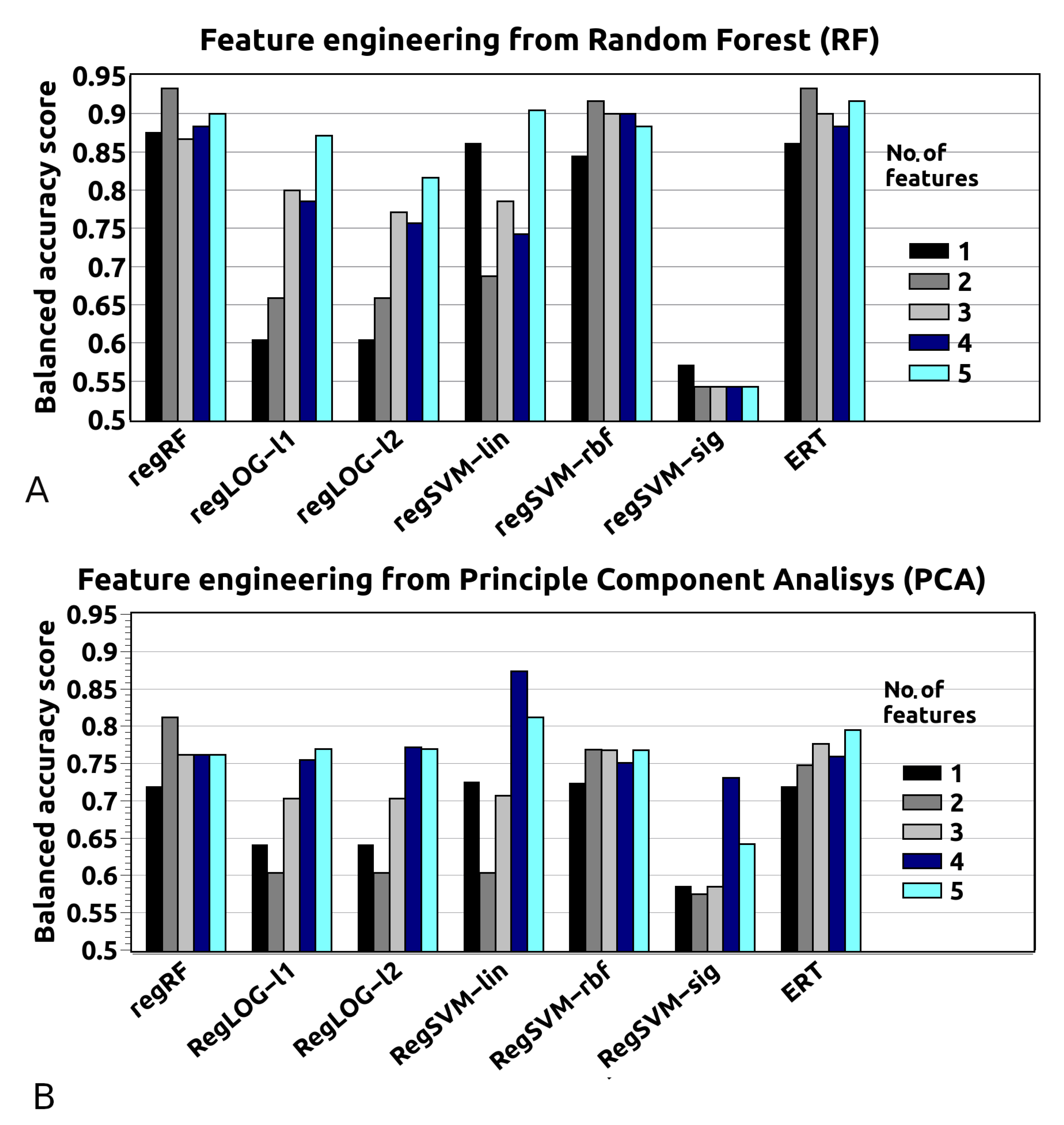
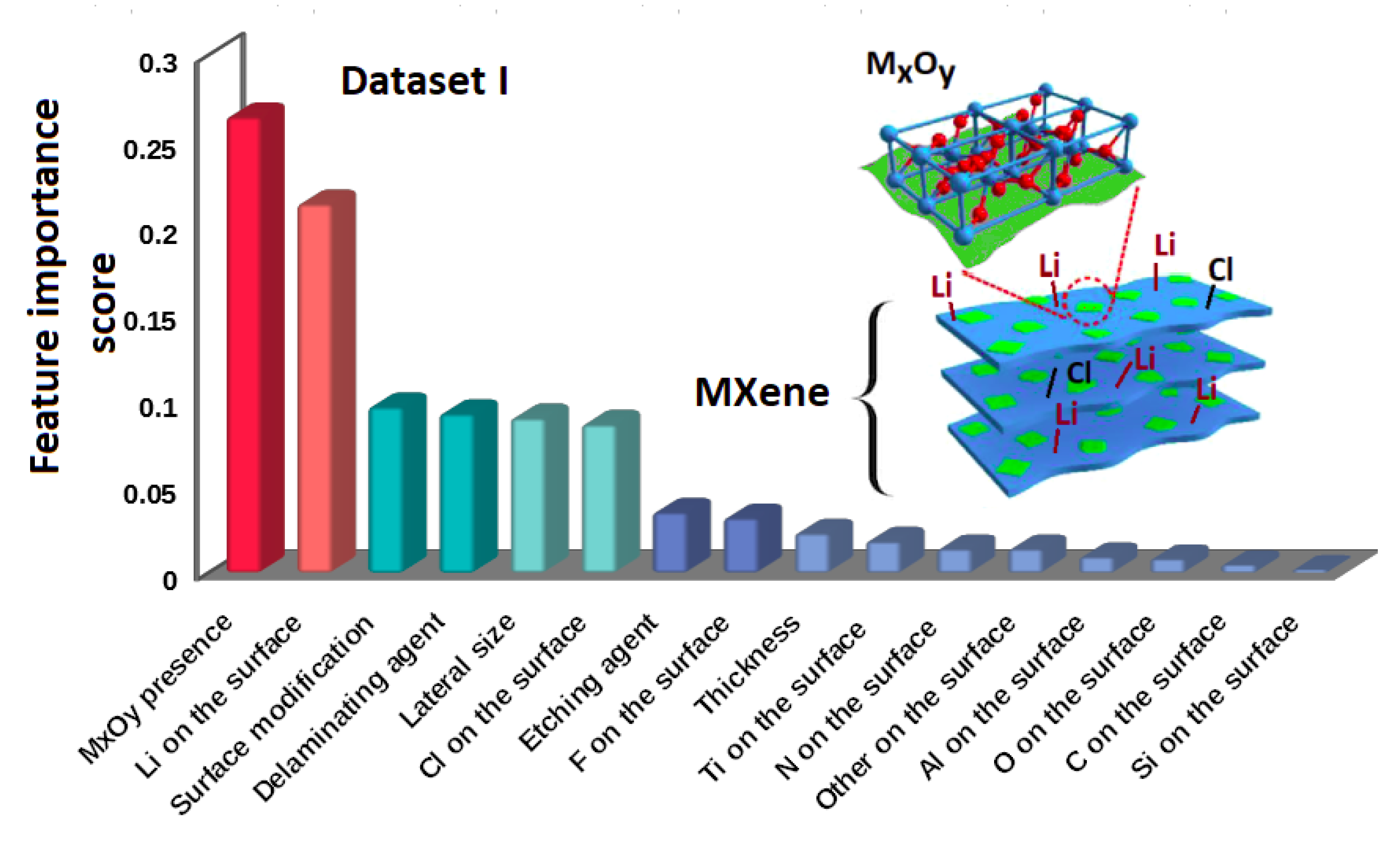
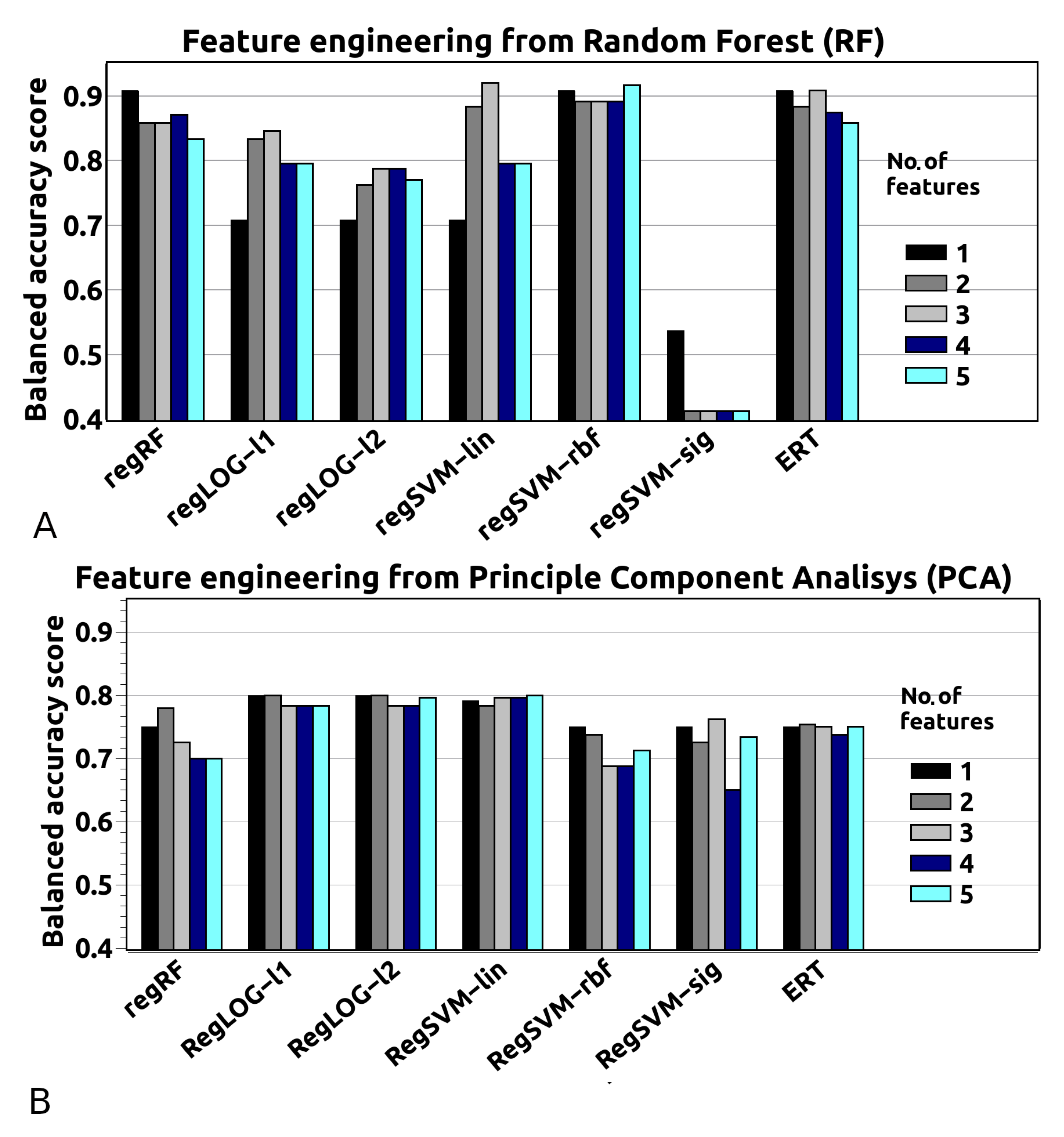
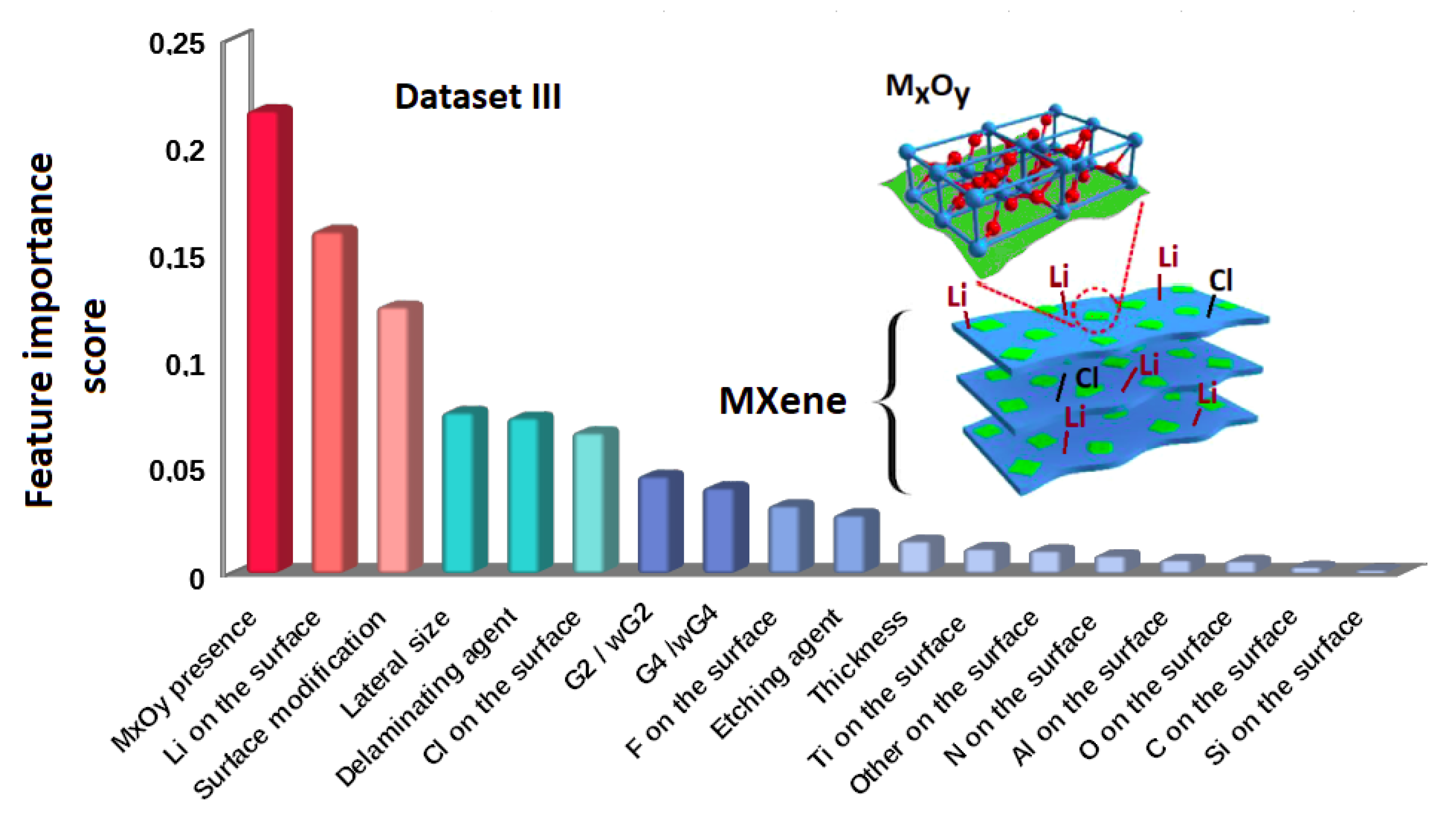
| Balanced Data | |||
|---|---|---|---|
| ML Algorithms | Unbalanced Data | Weight | SMOTE |
| regRF | 0.747 | 0.826 | 0.833 |
| regLOG-l1 | 0.700 | 0.776 | 0.783 |
| regLOG-l2 | 0.720 | 0.798 | 0.783 |
| regSVM-lin | 0.867 | 0.725 | 0.808 |
| regSVM-rbf | 0.662 | 0.917 | 0.933 |
| regSVM-sigmoid | 0.555 | 0.543 | 0.4042 |
| ERT | 0.722 | 0.776 | 0.750 |
| ML Algorithms | Model Selection: Weight |
|---|---|
| regRF | 0.845 |
| regLOG-l1 | 0.845 |
| regLOG-l2 | 0.727 |
| regSVM-lin | 0.781 |
| regSVM-rbf | 0.876 |
| regSVM-sigmoid | 0.545 |
| ERT | 0.793 |
| MXene [Ref.]: | Probability | MxOy | Li Atoms | Synthesis Procedure | Surface Mod. |
|---|---|---|---|---|---|
| Ti3C2 [41] | 0.18 | No | Yes | LiF/HCl; Us. | No |
| Ti3C2 [42] | 0.05 | No | No | HF | Au |
| Ti3C2 [43] | 0.18 | No | Yes | LiF/HCl; Us. | No |
| Ti3C2 [44] | 0.10 | No | No | HF; Us. | No |
| Ti3C2 [45] | 0.10 | No | No | HF; Us. | No |
| Ti3C2 [46] | 0.06 | No | Yes | LiF/HCl | APTES + CEA |
| Ti3C2 [47] | 0.07 | No | Yes | LiF/HCl; Us. | DNA, Pt, Pd |
| Ti3C2 [48] | 0.05 | No | No | HF; Us. | Ag |
| Ti3C2 [49] | 0.07 | No | Yes | LiF/HCl | L-ACC |
| Ti3C2 [50] | 0.07 | No | Yes | LiF/HCl; Us. | PAS |
| Ti3C2 [51] | 0.87 | Yes | No | LiF/HCl | No |
| Ti3C2 [52] | 0.88 | Yes | No | LiF/HCl | No |
| V2C [50] | 0.05 | No | Yes | LiF/HCl; Us. | PAS |
| V2C [53] | 0.05 | No | No | NaF/HCl | No |
| Nb2C [54] | 0.04 | No | No | NaF/HCl | No |
| Nb2C [55] | 0.04 | No | No | HF; 60∘ | No |
| Ti2N [10] | 0.05 | No | No | KF/HCl; Us. | No |
| Mo1.33C [56] | 0.04 | No | No | HF; TBAOH | No |
| Ti4N3 [57] | 0.03 | No | Yes | KF/LiF/NaF, TBAOH | No |
© 2020 by the authors. Licensee MDPI, Basel, Switzerland. This article is an open access article distributed under the terms and conditions of the Creative Commons Attribution (CC BY) license (http://creativecommons.org/licenses/by/4.0/).
Share and Cite
Marchwiany, M.E.; Birowska, M.; Popielski, M.; Majewski, J.A.; Jastrzębska, A.M. Surface-Related Features Responsible for Cytotoxic Behavior of MXenes Layered Materials Predicted with Machine Learning Approach. Materials 2020, 13, 3083. https://doi.org/10.3390/ma13143083
Marchwiany ME, Birowska M, Popielski M, Majewski JA, Jastrzębska AM. Surface-Related Features Responsible for Cytotoxic Behavior of MXenes Layered Materials Predicted with Machine Learning Approach. Materials. 2020; 13(14):3083. https://doi.org/10.3390/ma13143083
Chicago/Turabian StyleMarchwiany, Maciej E., Magdalena Birowska, Mariusz Popielski, Jacek A. Majewski, and Agnieszka M. Jastrzębska. 2020. "Surface-Related Features Responsible for Cytotoxic Behavior of MXenes Layered Materials Predicted with Machine Learning Approach" Materials 13, no. 14: 3083. https://doi.org/10.3390/ma13143083
APA StyleMarchwiany, M. E., Birowska, M., Popielski, M., Majewski, J. A., & Jastrzębska, A. M. (2020). Surface-Related Features Responsible for Cytotoxic Behavior of MXenes Layered Materials Predicted with Machine Learning Approach. Materials, 13(14), 3083. https://doi.org/10.3390/ma13143083





